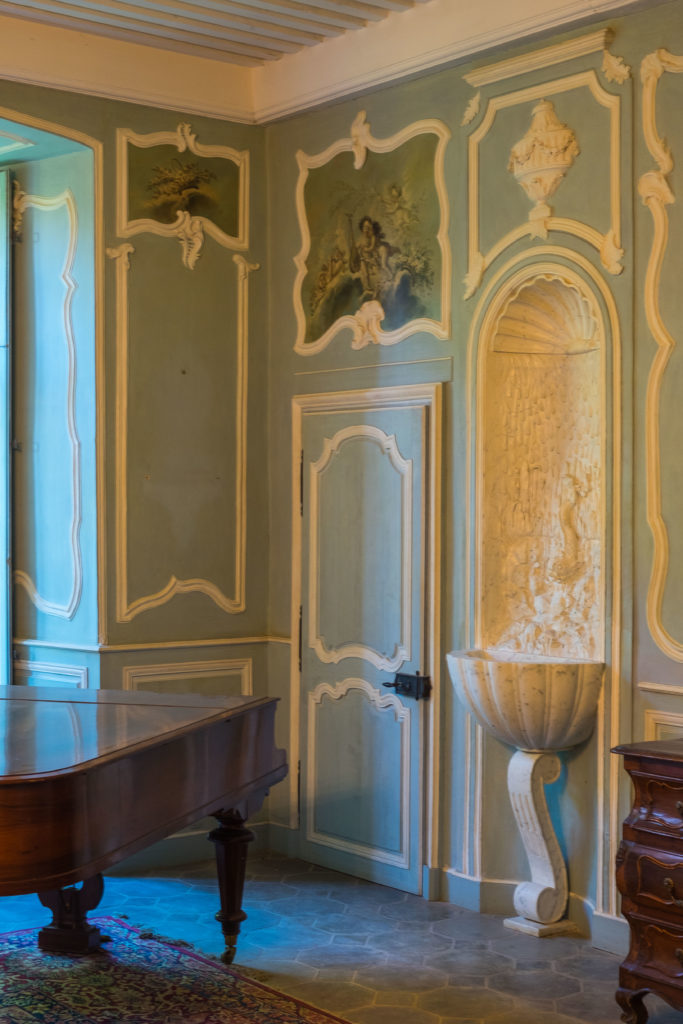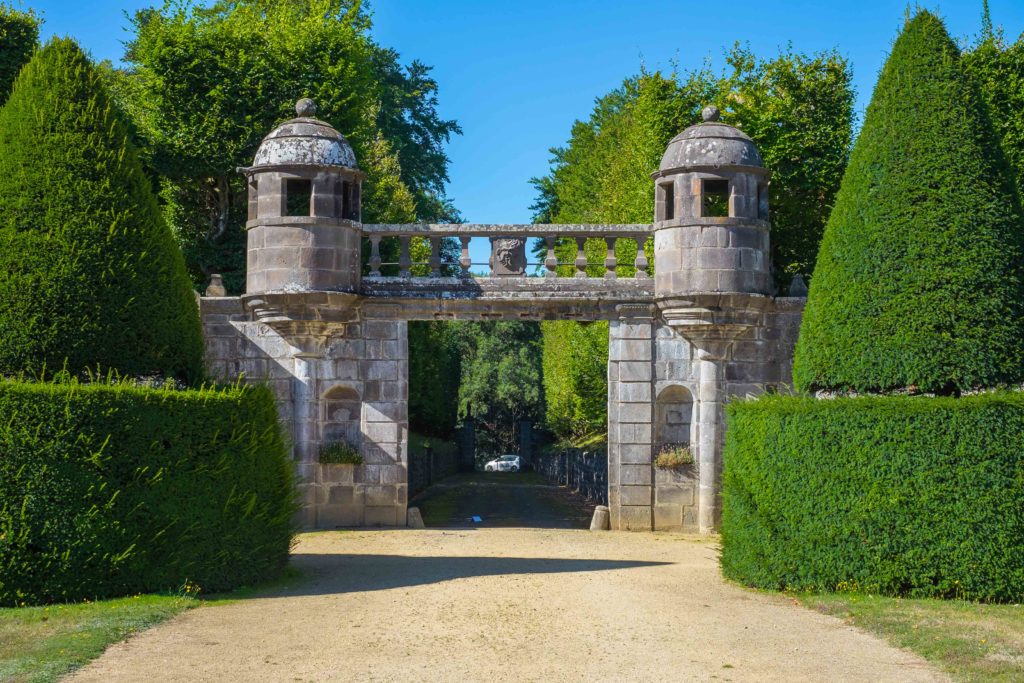Almost 3 years ago I told you about the beautiful small Chateau de Cordès, hidden far from the normal tourist paths in the mountains of central France. I mentioned then that, according to our guide, the castle's owners might be interested in selling the place if the right buyer came along. Well, now it IS for sale; for "only" 2.5 million Euros (US $2,970,254), you could live in a nationally-listed "Historic Monument" surrounded by gardens designed by the same guy who worked for King Louis XIV! Read about this historic chateau here, then check out the property listing on the Forbes Global Properties site.
--------------------------------------------------------------------------
Our guide at the Chateau de Cordès clearly loves his job. He’s also the “chief gardener” for the grounds around the castle (although he admits there’s only one other person on the staff), so for our tour he has scrubbed the dirt off his hands, tucked in his shirt, and opened the doors for the five of us at the height of tourist season in the Auvergne.
Feeling at home
It’s not really surprising to him (or to me) that the Chateau de Cordès is so lightly trafficked even at this peak time of the year. We are far removed from all the major tourist centers of France – distant even from most of the lesser known sites in the deep heart of the country, although the great Romanesque basilica of Orcival is just minutes down the road. But this is one of those medieval gems that appear so often in central France that you might think neighbors in the Middle Ages must have been constantly raising armies against their neighbors on the next hilltop, and I can’t resist the charm of places like this wherever I find them.


As we walk through the public rooms of the castle, I’m struck by how “homey” and comfortable it feels. It reminds me that there are at least three kinds of chateaux in the deep heart of France: the massive fortresses clearly built for heavy military action (like the Chateau de Murol further south of here), places that are called “chateaux” but which are really more like little palaces for minor noble families, and “in-between” castles like this one at Cordès.


A history of important families
Our guide tells us some of the house’s history. It was built beginning in 1268 C.E. by Guillaume de Chalus, and his family held on to the place for almost 400 years. The d'Allègre family bought it in 1659, and it served as their base as the family rose in prominence among the aristocrats of France. The guide told us how Yves, the Marquis d'Allègre, was responsible for turning the Chateau de Cordès into the comfortable place we see today; he became the military Marechal de France (Marshall of France) in 1724.
(It was Yves, too, who was responsible for the fine sculpted gardens that surround the castle. He brought André Le Nôtre, the gardener to King Louis XIV who created the spectacular landscaping at Versailles, down to this remote corner of the Auvergne in 1695 and asked him to rework the grounds at Cordès. It remains on the official list of “Remarkable Gardens of France” today.)


Outside the mainstream, but never out of history
As with many other small castles around this part of France, the Chateau de Cordès seems to have sailed through most of its existence outside the main currents of French history. Our guide tells us that it was never attacked by a besieging army, although its owners did put up strong defensive towers and a 3-cell prison in the dungeon against the possibility of an attack. Much of that defensive strength was destroyed, though, during the administration of Cardinal Richelieu in the early 1600s. The Cardinal, who was quick to see every castle in the kingdom as a possible military threat to the King of France, offered the owners of Cordès a choice: “demilitarize” their chateau, or have it destroyed.. They chose demilitarization, and parts of the crenelated towers came tumbling down.

Still, the Chateau de Cordès did not disappear altogether from the history books. Paul Bourget (nominated five times for the Nobel Prize in literature, although he never won) made the castle at Cordès the setting for his novel Le Démon de Midi in 1914. And the very remoteness of the castle, far from Paris and the zone of German Occupation, made it a relatively safe place for the University of Strasbourg and the French National Library to store their archives when they had to evacuate in 1939 in advance of the Nazi invasion of eastern France.



Touring the Chateau de Cordès
The castle today has been restored, along with its gardens, and resembles once again a comfortable (if somewhat threadbare) aristocratic country home. Our tour takes us through the “formal” rooms – I especially liked the Italian marble altar piece in the little chapel, and the fine 18th-century moldings in the salon. But we also got to see a little “behind the scenes” – the infrastructure of the house down in the gloomy basement and a large bedroom with rough wooden beams.



We end the tour in the castle’s attic, an amazing structural achievement where the heavy wood trusses support the massive weight of the slate roof. The conversation turns to practical matters; one of my fellow tourists asks “Est-ce rentable?” (“is this place profitable”) and our guide responds without hesitation: “Absolumment pas!” (“Absolutely not!”) He tells us that the current owner would be willing to sell the chateau if the right offer came along, but there are difficulties: one prospective buyer looked around and said, “I have to be able to get back to Paris in 45 minutes or less – if there’s no landing strip for my airplane I can’t possibly live here!”

Leaving by the back gate
Thanks to our guide's willingness to keep answering questions from our small group, the tour ends after the castle's official noon closing time. We exit into the bright afternoon sun, and our guide’s wife and little girl are waiting for him at the door to join them for lunch. By the time I walk back through the gardens to the parking area, the front gate has been shut and locked tight with a chain, so I have to walk along the fence line for half a mile until I find a back gate standing unlocked near the caretaker’s house.
It’s an example of the informality I’ve seen so often in this remote part of France – and a reminder of priorities (family and a good lunch first, the comfort of paying customers second). It’s also a good chance to experience the absolute quiet that exists this far out in the countryside, punctuated only by the occasional buzz of an insect or the loud mooing of a cow in the field next to the chateau. You can see forever from here, across the forests and volcanic peaks that make this part of the country so rugged ... and to be honest, for a second, it makes me wish I could stay here for a century or two myself…

Do you have a favorite place “off the beaten path of tourism” in France? Do you like things this remote from “civilization” – or do you prefer the urban life? What’s the most out-of-the-way place you’ve visited in France? Please share your experience in the comments section below – and take a second to share this post with someone else who likes the people, history, and sites of central France.





